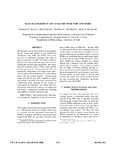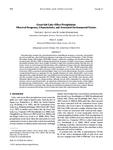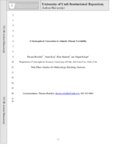1 - 25 of 19
| Creator | Title | Description | Subject | Date | ||
|---|---|---|---|---|---|---|
| 1 |
 |
Rosen, Paul Andrew | Data management and analysis with WRF and SFIRE | We introduce several useful utilities in development for the creation and analysis of real wildland fire simulations using WRF and SFIRE. These utilities exist as standalone programs and scripts as well as extensions to other well known software. Python web scrapers automate the process of downloadi... | 2012-01-01 | |
| 2 |
 |
Reichler, Thomas J.; Staten, Paul W. | Use of radio occultation for long-term tropopause studies: uncertainties, biases, and instabilities. | Research suggests that changes in tropopause structure can both indicate and impact changes in the global climate system. The Global Positioning System radio occultation (RO) technique shows tremendous potential for monitoring the global tropopause due to its precision, temporal consistency, and ... | Radio occultation; Tropopause; Climate | 2007 |
| 3 |
 |
Reichler, Thomas J. | Determining the tropopause height from gridded data | A method is presented to determine tropopause height from gridded temperature data with coarse vertical resolution. The algorithm uses a thermal definition of the tropopause, which is based on the concept of a threshold lapse-rate. Interpolation is performed to identify the pressure at which this th... | Meteorology and Atmospheric Dynamics: Stratosphere/troposphere interactions; Numerical modeling and data assimilation; Meteorology; Atmospheric Dynamics: General circulation | 2003 |
| 4 |
 |
Reichler, Thomas J.; Kim, Junsu | Uncertainties in the climate mean state of global observations, reanalyses, and the GFDL climate model | Climate research relies on realistic atmospheric data over long periods of time. Global reanalyses or observations are commonly used for this type of work. However, the many problems associated with both the reanalyses and observations cast doubts on the reliability of such data for climate appli... | Climate; Atmospheric data; Reanalyses | 2008 |
| 5 |
 |
Reichler, Thomas J. | GCIP water and energy budget synthesis (WEBS) | As part of the World Climate Research Program's (WCRPs) Global Energy and Water-Cycle Experiment (GEWEX) Continental-scale International Project (GCIP), a preliminary water and energy budget synthesis (WEBS) was developed for the period 1996-1999 from the "best available" observations and models. | Hydrologic cycle; Water cycle; Water and energy budgets; Regional models; Land surface models | 2002 |
| 6 |
 |
Steenburgh, William James | Great Salt Lake-effect precipitation: observed frequency, characteristics, and associated environmental factors | This climatology examines the environmental factors controlling the frequency, occurrence, and morphology of Great Salt Lake-effect (GSLE) precipitation events using cool season (16 September-15 May) Weather Surveillance Radar-1988 Doppler (WSR-88D) imagery, radiosonde soundings, and MesoWest surfac... | 2012-01-01 | |
| 7 |
 |
Steenburgh, William James | Episodic dust events of Utahs Wasatch Front and adjoining region | Episodic dust events cause hazardous air quality along Utah's Wasatch Front and dust loading of the snowpack in the adjacentWasatch Mountains. This paper presents a climatology of episodic dust events of the Wasatch Front and adjoining region that is based on surface weather observations from the Sa... | 2012-01-01 | |
| 8 |
 |
Reichler, Thomas J. | Role of boundary and initial conditions for dynamical seasonal predictability | The importance of initial state and boundary forcing for atmospheric predictability is explored on global to regional spatial scales and on daily to seasonal time scales. A general circulation model is used to conduct predictability experiments with different combinations of initial and boundary co... | Atmospheric predictions; Seasonal forecasting; Boundary forcing | 2002 |
| 9 |
 |
Reichler, Thomas J. | Multidecadal drought cycles in the Great Basin recorded by the Great Salt Lake: modulation from a transition-phase teleconnection | This study investigates the meteorological conditions associated with multidecadal drought cycles as revealed by lake level fluctuation of the Great Salt Lake (GSL). The analysis combined instrumental, proxy, and simulation datasets, including the Twentieth Century Reanalysis version 2, the North Am... | 2012-01-01 | |
| 10 |
 |
Reichler, Thomas J. | Expansion of the Hadley cell under global warming | A consistent weakening and poleward expansion of the Hadley circulation is diagnosed in the climate change simulations of the IPCC AR4 project. Associated with this widening is a poleward expansion of the subtropical dry zone. Simple scaling analysis supports the notion that the poleward extent of ... | Hadley cell; Climate change; Subtropical dry zone | 2007 |
| 11 |
 |
Reichler, Thomas J. | Breaking down the tropospheric circulation response by forcing | This study describes simulated changes in the general circulation during the twentieth and twenty -first centuries due to a number of individual direct radiat ive forcings and warming sea surface temperatures, by examining very long time-slice simulations created with an enhanced version of the Geop... | 2012-01-01 | |
| 12 |
 |
Garrett, Timothy J. | Observed influence of riming, temperature, and turbulence on the fallspeed of solid precipitation | Forecasts of the amount and geographic distribution of snow are highly sensitive to a model's parameterization of hydrometeor fallspeed. Riming is generally thought to lead to particles with a higher mass and terminal velocity. Yet models commonly assume that heavily rimed particles such as graupel ... | 2014-01-01 | |
| 13 |
 |
Garrett, Timothy J. | Fall speed measurement and high-resolution multi-angle photography of hydrometeors in free fall | We describe here a new instrument for imaging hydrometeors in free fall. The Multi-Angle Snowflake Camera (MASC) captures high-resolution photographs of hydrometeors from three angles while simultaneously measuring their fall speed. Based on the stereoscopic photographs captured over the two months ... | 2012-01-01 | |
| 14 |
 |
Steenburgh, William James | Finescale orographic precipitation variability and gap-filling radar potential in Little Cottonwood Canyon, Utah | Finescale variations in orographic precipitation pose a major challenge for weather prediction, winter road maintenance, and avalanche forecasting and mitigation in mountainous regions. In this investigation, ground based X-band radar observations collected during intensive observing period 6 (IOP6)... | 2014-01-01 | |
| 15 |
 |
Garrett, Timothy J. | Novel basis for interpreting recent acceleration of anthropogenic carbon dioxide emissions | This paper presents a simple thermodynamic model for understanding economic and carbon dioxide emissions growth. | Thermodynamics; Economics; Climate; Growth | 2008 |
| 16 |
 |
Reichler, Thomas J. | A stratospheric connection to Atlantic climate variability | It is well recognized that the stratosphere is connected to tropospheric weather and climate. In particular, extreme stratospheric circulation events and their dynamical feedback on the troposphere are known to play a major role1. However, what is not known to date is whether the state of the strat... | 2012-01-01 | |
| 17 |
 |
Garrett, Timothy J. | No way out? the double-bind in seeking global prosperity alongside mitigated climate change | In a prior study (Garrett, 2011), I introduced a simple economic growth model designed to be consistent with general thermodynamic laws. Unlike traditional economic models, civilization is viewed only as a well-mixed global whole with no distinction made between individual nations, economic sectors,... | 2012-01-01 | |
| 18 |
 |
Garrett, Timothy J. | Are there basic physical constraints on future anthropogenic emissions of carbon dioxide? | Global Circulation Models (GCMs) provide projections for future climate warming using a wide variety of highly sophisticated anthropogenic CO2 emissions scenarios as input, each based on the evolution of four emissions "drivers": population p, standard of living g, energy productivity (or efficiency... | Global circulation models; Anthropogenic carbon dioxide emissions | 2009 |
| 19 |
 |
Garrett, Timothy J. | Gains in economic energy efficiency as the impetus for increasing atmospheric carbon dioxide | Growth of anthropogenic carbon dioxide (CO2) emissions is frequently diagnosed as a product of population, per capita economic production, the energy intensity of economic production (or inverse of its energy efficiency), and the carbon intensity of energy. This paper introduces an alternative, p... | carbon dioxide, energy efficiency, economics | 2007-12-17 |
1 - 25 of 19
